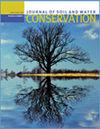北卡罗莱纳州森林河流过境点土壤侵蚀和最佳管理实践有效性评估
IF 2.6
4区 农林科学
Q2 ECOLOGY
引用次数: 1
摘要
如果管理不当,林道和滑径河道的通道可以成为泥沙输送到河道的直接途径。林业最佳管理实践(BMPs)可以减少侵蚀和沉积,但其效果因应用而异。本研究描述了已实施的河流过境类型和通行方法,并量化了北卡罗来纳州四个生态区220个河流过境点实施的bmp的有效性。我们使用通用土壤流失方程(USLE)-森林方法估算土壤侵蚀速率和数量。通过比较现场模型估计和修正模型估计来探索BMP有效性的估计,修正模型估计将更能辨别无BMP情景。在全州范围内,便携式桥梁和陆上滑轨分别是最常见的河流穿越类型和通道方法。在河流过境点适当实施bmp的比率为90.1%。虽然BMP实现评分的增加与侵蚀估计的减少显著相关,但这种关系是弱相关的(p & 0.0001, R2 = 0.08)。不同生态区域模拟的侵蚀速率没有差异(p = 0.2671)。在全州范围内,陆上滑道交叉口的模型侵蚀率低于有叶片的滑道(p = 0.0432)和运输道路(p = 0.0002)。与非活动或封闭的河流渡口相比,在河流渡口有活动的河流渡口模拟的侵蚀率明显更高(p & 0.0001)。大多数观察到的河流过境点(54%)的侵蚀量小于0.1 Mg,过境- 1 y-1。结果表明,在这项研究中,北卡罗莱纳州大多数与森林有关的河流过境点充分应用了bmp,减少了侵蚀潜力。本文章由计算机程序翻译,如有差异,请以英文原文为准。
Estimates of soil erosion and best management practice effectiveness at forestry stream crossings in North Carolina
Approach ways of forest road and skid trail stream crossings can be direct pathways for sediment delivery to stream channels if not properly managed. Forestry best management practices (BMPs) can reduce erosion and sedimentation, but their effectiveness can vary by application. This study characterizes implemented stream crossing types and methods of access, and quantifies the effectiveness of BMPs implemented at 220 stream crossings in four ecoregions of North Carolina. We estimated soil erosion rate and quantity using the Universal Soil Loss Equation (USLE)-Forest methodology. Estimates of BMP effectiveness were explored by comparing on-site modeled estimates with modified modeled estimates that would be more discerning of no-BMP scenarios. Statewide, portable bridges and overland skid trails were the most frequently observed stream crossing type and access method, respectively. BMPs at stream crossings were properly implemented at a rate of 90.1%. Although increased BMP implementation scores were significantly associated with decreasing erosion estimates, the relationship was weakly correlated (p & 0.0001, R2 = 0.08). There were no differences in modeled erosion rates by ecoregion (p = 0.2671). Statewide, overland skid trail crossings had lower modeled erosion rates than bladed skid trails (p = 0.0432) and haul roads (p = 0.0002). Erosion rates modeled at stream crossings when the tract had active operations were significantly higher compared to stream crossings on inactive/closed tracts (p & 0.0001). Most stream crossings observed (54%) had modeled erosion quantities less than 0.1 Mg crossing–1 y–1. Results show that most forestry-related stream crossings examined in this study across North Carolina adequately applied BMPs and reduced erosion potential.
求助全文
通过发布文献求助,成功后即可免费获取论文全文。
去求助
来源期刊
CiteScore
4.10
自引率
2.60%
发文量
0
审稿时长
3.3 months
期刊介绍:
The Journal of Soil and Water Conservation (JSWC) is a multidisciplinary journal of natural resource conservation research, practice, policy, and perspectives. The journal has two sections: the A Section containing various departments and features, and the Research Section containing peer-reviewed research papers.

 求助内容:
求助内容: 应助结果提醒方式:
应助结果提醒方式:


